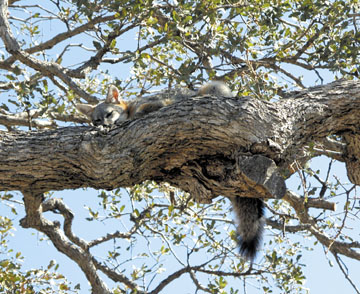
The wonderful thing about living on Figueroa Mountain is you never know what you may experience. As recently as October we had a young grey fox in an oak tree near our back door. It seemed strange to us, but in doing a little research I think I know why this beautiful and elusive creature paid us a visit.
To begin with, foxes are primarily nocturnal animals, which means they are active hunting at night and return to their makeshift dens during the day. The grey fox doesn’t actually dig a den but instead rests in crevices, under boulders or in hollow logs. Grey foxes are the most common fox in California and primarily populate the coastal and chaparral regions.
During the breeding season, male and female foxes pair off and stay together only until the young are born and then the female fox kicks the male out. In general, the grey fox forages for fruit, berries, acorns or other plant material and will eat small rodents and insects.
In the case of this young fox, we think he was in the wrong place at the wrong time. He must have been checking out our yard for any left over dog food we put out for Jake, our old cattle dog, when he encountered a coyote. Coyotes and foxes are territorial, and the two must have tangled when they bumped into each other. At around midnight I heard a scream reminiscent of one of the neighbor’s cats, but the next day, instead of finding evidence of a cat, we found the young fox in the oak tree.
According to various sources, the Grey fox is the only member of the dog family that can climb trees. In order to climb, it must grab the tree trunk with its forepaws and scramble up with the long claws on its hind feet; I imagine it looks like a tree trimmer shimmying up into the branches. For the rest of the day, and until sunset, the fox remained in the tree either lying down or walking along one of the main limbs of the tree. A few minutes after the sun began setting the fox was gone.
Chances are you will see a grey fox darting across the road or rushing through the brush on its quest to forage, hunt, check its territory or bring food back to its den.
For a close-up view of a stuffed grey fox, go to the Santa Ynez Valley Historical Museum in Santa Ynez; that is the closest non-living one I know about.









